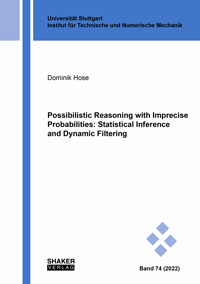
Shop : Details
Shop
Details
49,80 €ISBN 978-3-8440-8721-5Softcover236 pages87 figures350 g21 x 14,8 cmEnglishThesis
August 2022
Dominik Hose
Possibilistic Reasoning with Imprecise Probabilities: Statistical Inference and Dynamic Filtering
Two effects can often be observed when checking numerical simulation models against measured data from the described physical systems.
On the one hand, a precise specification of all parameters in these models is often impossible for various reasons---sometimes, they do not even describe any physical quantities that could be measured.
Moreover, many physical processes contain a natural degree of variability which cannot be described by deterministic models, not even by highly accurate ones. If actual measurements are to be used to calibrate the model, i.e. its unknown parameters, it is evident that noisy data will never allow an exact inference. This inexactness, in turn, implies that arbitrarily accurate statements, especially predictions, cannot be made about the behavior of the physical system. Such observations provide a direct motivation for uncertainty quantification, which aims to describe, quantify, and compute these very uncertainties.
This thesis considers possibilistic methods for statistical inference with imprecise probabilities. In this sense, it belongs to a young subfield of statistics and uncertainty quantification which has its origins in the Dempster-Shafer theory of evidence and the theory of fuzzy sets by Zadeh.
More precisely, it makes a contribution to the applied theory of imprecise probabilities by linking theoretical and numerical insights with practical applications in engineering and showing how possibilistic methods can be used profitably.
Moreover, many physical processes contain a natural degree of variability which cannot be described by deterministic models, not even by highly accurate ones. If actual measurements are to be used to calibrate the model, i.e. its unknown parameters, it is evident that noisy data will never allow an exact inference. This inexactness, in turn, implies that arbitrarily accurate statements, especially predictions, cannot be made about the behavior of the physical system. Such observations provide a direct motivation for uncertainty quantification, which aims to describe, quantify, and compute these very uncertainties.
This thesis considers possibilistic methods for statistical inference with imprecise probabilities. In this sense, it belongs to a young subfield of statistics and uncertainty quantification which has its origins in the Dempster-Shafer theory of evidence and the theory of fuzzy sets by Zadeh.
More precisely, it makes a contribution to the applied theory of imprecise probabilities by linking theoretical and numerical insights with practical applications in engineering and showing how possibilistic methods can be used profitably.
Keywords: Uncertainty Quantification; Statistical Inference; Possibility Theory; Filtering; Imprecise Probabilities
Schriften aus dem Institut für Technische und Numerische Mechanik der Universität Stuttgart
Edited by Prof. Dr.-Ing. Peter Eberhard, Stuttgart
Volume 2022,74
Available online documents for this title
You need Adobe Reader, to view these files. Here you will find a little help and information for downloading the PDF files.
Please note that the online documents cannot be printed or edited.
Please also see further information at: Help and Information.
Please also see further information at: Help and Information.
| Document |  | Document | ||
| Type |  | |||
| Costs |  | 37,35 € | ||
| Action |  | Purchase in obligation and download the file | ||
| Document |  | Table of contents | ||
| Type |  | |||
| Costs |  | free | ||
| Action |  | Download the file | ||
User settings for registered online customers (online documents)
You can change your address details here and access documents you have already ordered.
User
Not logged in
Export of bibliographic data
Shaker Verlag GmbH
Am Langen Graben 15a
52353 Düren
Germany
Am Langen Graben 15a
52353 Düren
Germany
Mon. - Thurs. 8:00 a.m. to 4:00 p.m.
Fri. 8:00 a.m. to 3:00 p.m.
Fri. 8:00 a.m. to 3:00 p.m.
Contact us. We will be happy to help you.



